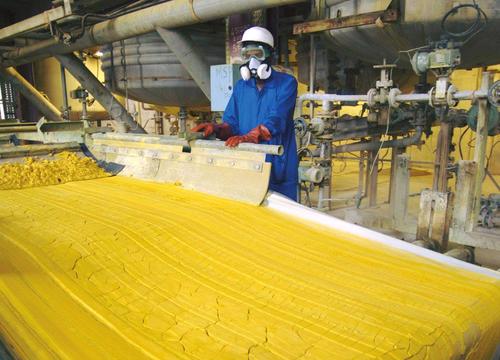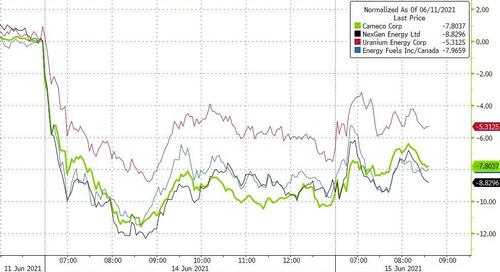The Biden administration is taking steps to establish a US uranium reserve, a proposal put forward by the Trump administration which could boost mining of the mineral as well as the potential to expand nuclear energy in the United States.

In Tuesday testimony before the Senate Energy and Natural Resources Committee, Energy Secretary Jennifer Granholm said that her department is laying the groundwork for such a move.
“We’re about to issue a request for information [RFI] regarding establishing a reserve,” she said, adding “We are, I think this month, issuing an RFI on that.”

In a major funding bill passed late last year, Congress set aside funds to establish the strategic reserve, which would buy US-mined uranium from domestic producers, which we assume is separate from the US reserves bought by Russia during Hillary Clinton’s Uranium One scandal.
When asked why the Biden administration’s budget request for 2022 didn’t include funding for the reserve, Granholm cited the existing funding for the project.
“It had been appropriated for last year so it’s carrying over,” she said.
A 2020 Trump administration report endorsed spending millions on the reserve, which would aim to boost domestic mining.
The concept is similar to that of the already existing strategic petroleum reserve, where the government can hold up to 714 million barrels of that fuel in case of an emergency. –The Hill
Zero Hedge readers will recall our coverage on the uranium sector, which we said in April was set to benefit from several factors – including upcoming infrastructure spending, the reddit short squeeze crowd, an extremely bullish case laid out by a BofA analyst, and a passionate tweetstorm by former hedge fund manager Hugh Hendry, who said “A lot of you are invested in uranium. I commend you. I wish I was. Uranium is the rockstar of commodities. It doesn’t mess around – bull and bear markets are of epic proportions.”
Furthermore, Michael “big short” Burry advocated for converting US to nuclear power as a way for Democrats to create jobs in a ‘green’ industry.
Related stocks moved higher on the news.
And to review what we said in April:
The first reason is a mix of regulatory and market developments.
As we reported earlier today, the spot price for U3O8 moved above $30 per pound for the first time this year as uranium producers and mine developers hoovered up above-ground inventories and reactor construction continues apace. Two new research notes from BMO Capital Markets and Morgan Stanley say today’s price marks a floor and predict a rally in prices over the next few years to the ~$50 level by 2024, which – all else equal – would translate into soaring stock prices for names such as CCJ, UEC, URA and URNM.
Indeed, as Mining.com said, the stars seem to be aligning for a new phase of nuclear energy investment with the US, China and Europe bolstering the bull case for the fuel this month.
And while nuclear energy was not (yet) mentioned explicitly in the $2 trillion Biden infrastructure proposal released today, its federally mandated “energy efficiency and clean electricity standard” is hardly achievable without it.
Curiously, the big regulatory move may be coming out of Europe, where – as we expected – Uranium is now officially part of the cool ESG crowd as over the weekend leaked documents showed a panel of experts advising the EU is set to designate nuclear as a sustainable source of electricity which opens the door for new investment under the continent’s ambitious green energy program.
Then there is China – as Mining.com notes, China’s 14th five-year plan released a fortnight ago also buoyed the uranium market with Beijing planning to up the country’s nuclear energy capacity by 46% – from 48GW in 2020 to 70GW by 2025. There are several factors working in uranium’s favor, not least the fact that annual uranium demand is now above the level that existed before the 2011 Fukushima disaster when Japan shut off all its reactors:
-
Uranium miners, developers and investment funds like Yellow Cake (13m lbs inventory build up so far) are buying material on the spot market bringing to more normal levels government and utility inventories built up over the last decade
-
Major mines are idled including Cameco’s Cigar Lake (due to covid-19) which accounts for 18m lbs or 13% of annual mine supply. The world’s largest uranium operation McArthur River was suspended in July 2018 taking 25m lbs off the market
-
Permanent closures so far this year include Rio Tinto’s Ranger operation in Australia (3m lbs) and Niger’s Cominak mine (2.6m lbs) which had been in operation since 1978. Rio is exiting the market entirely following the sale of Rössing Uranium in Namibia
-
Like Cameco, top producer Kazatomprom, which mined 15% less material last year due to covid restrictions has committed to below capacity production (–20% for the state-owned Kazakh miner) for the foreseeable future
-
Price reporting agency and research company UxC estimates that utilities’ uncovered requirements would balloon to some 500m lbs by 2026 and 1.4 billion lbs by 2035
-
Roughly 390m lbs are already locked up in the long term market while 815m lbs have been consumed in reactors over the last five years, according to UxC
-
There are 444 nuclear reactors in operation worldwide and another 50 under construction – 2 new connections to the grid and one construction start so far in 2021
-
Much cheaper and safer, small modular nuclear power reactors which can readily slot into brownfield sites like decommissioned coal-fired plants (or even underground or underwater) are expected to become a significant source of additional demand.
The last bullet brings us to reason number 2: the coming “small modular reactor” frenzy:
As Nikkei Asia reports today, one of Japan’s top industrial engineering companies will join a US-led project to build a new type of nuclear power plant designed with added precautions against meltdowns. These plants will be built in the US, where they will propel the uranium sector to level it hasn’t seen in decades (indicatively CCJ traded roughly double where it is today as just before the 2008 financial crisis).
According to the Nikkei, Japan’s JGC Holdings will help build a plant in the state of Idaho designed by NuScale Power, an American company whose proposal for a small modular reactor (SMR) involves immersing the containment units in a pool of water.
Small nuclear reactors have been hailed as an option for replacing fossil fuel power plants as nations commit to cutting carbon dioxide emissions in the coming decade
And here, we get one step closer to Uranium becoming part of ESG: when Joe Biden meets Japanese Prime Minister Yoshihide Suga for a summit in the U.S. later this month, fighting climate change will be on the agenda and “small nuclear” – and uranium – will be high on the agenda.
JGC has invested $40 million for a roughly 3% stake in NuScale, one player in the emerging field of SMRs. The Japanese group will work with NuScale’s parent, U.S.-based engineering company Fluor, on construction management and other aspects of the Idaho project.
One thing is clear: as the SMR strategy takes off, much more uranium will be needed, as the partners eventually could set their sights on similar projects in the Middle East – where JGC boasts a long track record in oil and petrochemical infrastructure – and Southeast Asia. In fact, the entire world could soon be covered in small, safe nukes which will lead to an unprecedented renaissance for the uranium sector.
Why the scramble for SMR?
The first reason is simple: price. Nuclear plants on the scale of 1,000 megawatts cost around $10 billion to build using established reactor designs. NuScale’s SMR design – which completed a technical review by the U.S. Nuclear Regulatory Commission in August 2020, ahead of rival proposals – reportedly costs around $3 billion for more than 900 MW. The Idaho plant will have a capacity between 600 MW and more than 700 MW, according to announced plans. NuScale also has a strategic partnership with South Korea’s Doosan Heavy Industries and Construction, which will supply components for the plant.
The second, and far more important reason, is safety. Japan’s Fukushima nuclear disaster a decade ago shows what happens when reactor cooling systems break down. The loss of emergency power after a devastating 2011 tsunami led to reactor meltdowns at the Fukushima Daiichi plant operated by Tokyo Electric Power Co. Holdings. Well, NuScale’s SMR design seeks to remove this risk, as the water in the pool takes a month to evaporate and helps keep the reactor’s temperature down.
The U.S. government supports research and development in small-scale reactors. A Green Growth Strategy announced by Japan last year calls for “providing active support” to Japanese companies participating in experimental overseas projects in this field. Many existing nuclear plants in Japan, the U.S. and other advanced economies have been in operation for decades and require upgrades or decommissioning.
In short, between recent bullish market dynamics, and a sector that is on the cusp of becoming the next ESG craze, the promise of new SMR technologies could ensure uranium demand is stable for decades, leading to a new golden age for uranium stocks.


